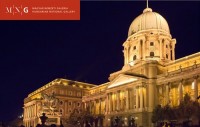Mednyánszky started depicting vagabonds during his stay in Paris in the 1890s. Most sensitively responsive to the human soul, Mednyánszky could express his thoughts about their struggles best in painting portraits. His social sensitivity made him sympathize with the down-and-out of society. Head of a Tramp is one of the few works that show carefully elaborated heads. It was probably a study for the figure of the vagabond resting by the fire in his Wretch. The most striking feature of this small portrait is the pair of eyes expressing deep sorrow and loneliness. Despair, destitution, helplessness are indicated by the face emphasized in front of the dark background by a peculiar light effect. The glowing bluish patch on the left of the head enhances the feeling of sorrow. The picture holds a special place among Mednyánszky’s pictures of vagabonds because he depicts the hopeless fate of these poor people with the tools of psychological painting, with melancholic emotions yet great dramatics.
en

